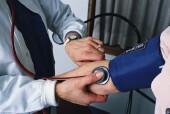BP control no better in overall cohort, but improved for participants from racial minority groups
FRIDAY, March 27, 2015 (HealthDay News) — A physician/pharmacist collaborative model can improve mean blood pressure (BP), according to a study published online March 24 in Circulation: Cardiovascular Quality and Outcomes.
Barry L. Carter, Pharm.D., from the University of Iowa in Iowa City, and colleagues examined the effect of a physician/pharmacist collaborative model on BP in 625 subjects. The authors conducted a prospective, cluster-randomized trial of 32 primary care offices stratified and randomized to control, brief (nine months) intervention, and sustained (24 months) intervention.
The researchers found that the primary outcome of BP control at nine months was 43 percent among 401 participants in the intervention offices and 34 percent among 224 participants in the control group (adjusted odds ratio, 1.57; 95 percent confidence interval, 0.99 to 2.50; P = 0.059). At nine months, the adjusted difference in mean systolic/diastolic BP between the intervention and control groups was −6.1/−2.9 mm Hg (P = 0.002 and 0.005, respectively) for all subjects, and −6.4/−2.9 mm Hg (P = 0.009 and 0.044, respectively) for participants from racial and ethnic minorities. Compared with the control group, in intervention offices, BP control and mean BP were significantly improved in subjects from racial minorities at 18 and 24 months (P = 0.048 to P < 0.001).
“The findings for secondary end points suggest that team-based care using clinical pharmacists was implemented in diverse primary care offices and BP was reduced in subjects from racial minority groups,” the authors write.
Copyright © 2015 HealthDay. All rights reserved.








